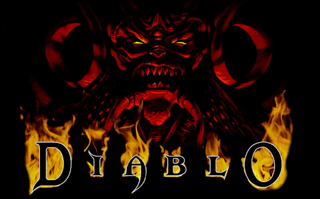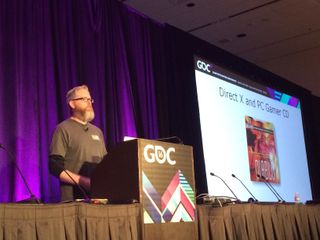The moment the action-RPG was born

Diablo wasn’t the first real-time RPG. Games like Ultima VII preceded it by years, as did console ancestors like Castlevania II, Zelda, and stuff like Xanadu. But Diablo birthed the ARPG as we know it today—its hotbars, levels of generated dungeons, and other features that still stick. At GDC last week, co-founder of Blizzard North, David Brevik (who's now at Graybeard Games) gave a deep look into the making of Diablo, bringing with him an original design document (which he uploaded over the weekend).
One of the most interesting parts of Brevik’s post-mortem talk focused on Diablo’s origin as a “complicated turn-based game.” As the lead programmer, Brevik was completely committed to this design. His colleagues at Blizzard weren't. “Eventually Blizzard South approached us and said, ‘We’d really like to make this a real-time game.’ And I said, ‘What are you guys talking about? Real-time? No, no, no, no, this isn’t one of your strategy games,” he said, referring to Warcraft.

Brevik said he wanted Diablo to capture the anxious decision-making that games like Wizardry and Rogue produced: “I really loved that tension, I really loved the sweaty palms of ‘I’ve been working on this thing and I’m about to lose two weeks of work.’ So I didn’t want to lose that at all. [Blizzard] said ‘Yeah, but, you know, real-time will be better.’ Finally one day we decide to bring it to a vote. So we all met in the kitchen and we voted, and I voted no and everybody else voted yes. And so I said, ‘All right, well, I guess we can do this.”
As he agreed to change the design, though, Brevik says he negotiated for more money to complete the project. “I called up Blizzard South and said, ‘This will be a huge delay in the project, it’s going to take us a long time, we have to re-do all sorts of things, it’s going to take me forever to [program] this. We need another milestone payment out of this, but we’ll go ahead and do it.’ They agreed to this. So I sat down on a Friday afternoon and in a few hours I had it running,” Brevik said, laughing.
The ARPG epiphany
Brevik described the moment Diablo transitionedfrom turn-based to real-time as one of the most vivid moments of his career. The fix was surprisingly simple, but its impact was big. “I just made the turns happen 20 times a second, or whatever it was, and it all just kind of worked, magically,” he said. “I remember taking the mouse. I clicked on the mouse, and the warrior walked over and smacked the skeleton down. And I was like, ‘Oh my god! ...That was awesome!’ And the sun shone through the window, and god passed by, and the angels sung and sure enough, that was when the ARPG was kinda born, at that moment. And I was lucky enough to be there, it was an amazing, amazing moment, I’ll never forget it.” Brevik said this change, which happened about six months into development, was a turning point in the project.
Where's our credit?
Diablo’s marketing was also mentioned during the talk, and the positive impact that being featured on the PC Gamer demo disc had for Blizzard. The Diablo demo was bundled with the issue that went out in October 1996, about two months before the release of Diablo, but it was surprisingly different from the final release. As Brevik demonstrates in the video above, the Diablo’s first boss appeared on the first level of the demo, and much of the dialogue appears to be placeholder. Primary UI was also incomplete, but feedback that Blizzard received from the demo helped them invent the hotbar in the final months of the project. We can’t take all the credit, though: the demo was also distributed on a DirectX CD that Microsoft distributed widely.
The biggest gaming news, reviews and hardware deals
Keep up to date with the most important stories and the best deals, as picked by the PC Gamer team.

Evan's a hardcore FPS enthusiast who joined PC Gamer in 2008. After an era spent publishing reviews, news, and cover features, he now oversees editorial operations for PC Gamer worldwide, including setting policy, training, and editing stories written by the wider team. His most-played FPSes are CS:GO, Team Fortress 2, Team Fortress Classic, Rainbow Six Siege, and Arma 2. His first multiplayer FPS was Quake 2, played on serial LAN in his uncle's basement, the ideal conditions for instilling a lifelong fondness for fragging. Evan also leads production of the PC Gaming Show, the annual E3 showcase event dedicated to PC gaming.
Most Popular

